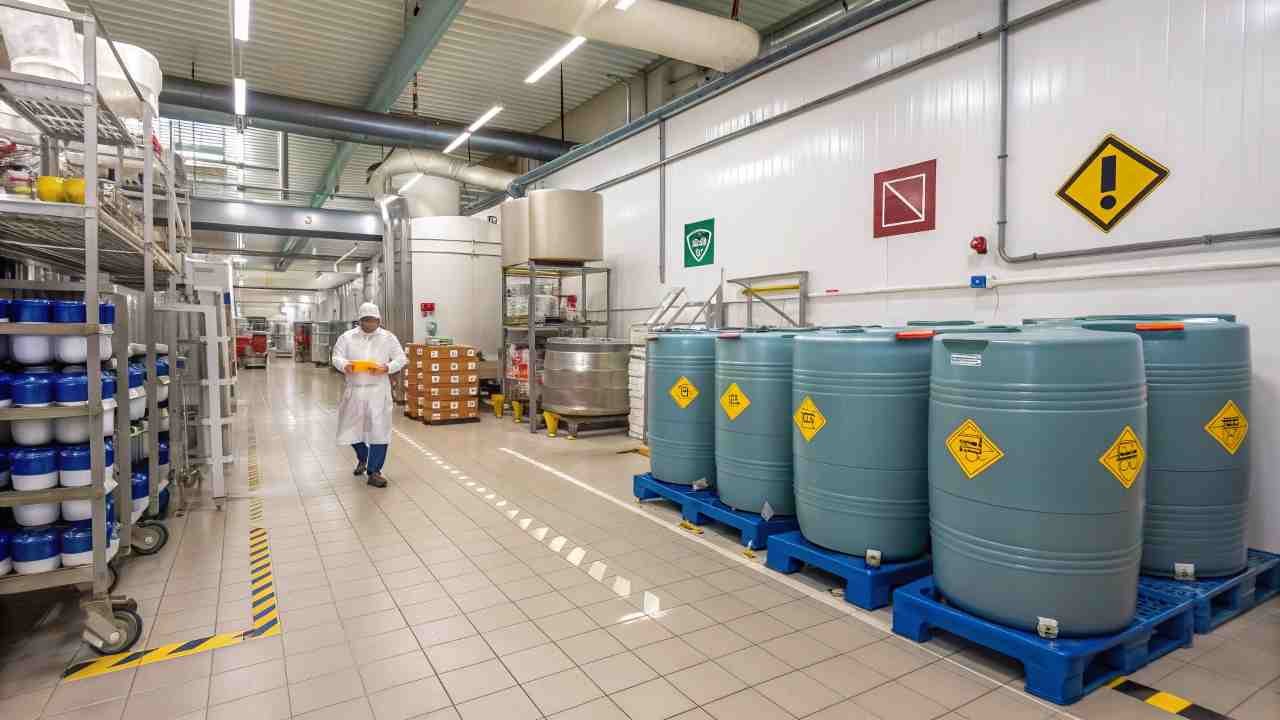Worried about food allergies? Vitamin E is in many products. What if someone is allergic? How do you make sure your food is safe for everyone?
Vitamin E allergies are rare, especially from consumption. Reactions are usually from skin contact. However, food producers must know about potential sensitivities and manage sources, labeling, and production to protect consumers.
Dealing with any allergy concern needs care in food production. Let's look at the facts about Vitamin E and what steps you can take.
How prevalent are Vitamin E allergies in consumers?
You use Vitamin E in your products. Should you worry about lots of people being allergic? How common is this really?
Vitamin E allergy, particularly from eating it, is very uncommon. Most reported reactions are contact dermatitis (skin rash) from topical products like creams. Serious allergic reactions from eating Vitamin E are extremely rare.

It's easy to get worried about allergies, but it helps to know the real picture.
Types of Vitamin E and Reactions
Vitamin E is a group of compounds, mainly tocopherols. It's not a protein. True allergies are often to proteins.
- True Food Allergy: This is IgE-mediated, potentially severe. It is extremely rare for Vitamin E from food.
- Contact Dermatitis: This is a skin rash from contact. This is the most common "Vitamin E allergy1," usually from topical products, not food.
Prevalence
Data confirms contact dermatitis from topical Vitamin E is reported. Food allergy to Vitamin E is not a significant category in allergy databases. When reactions happen after eating Vitamin E, the real cause is usually something else in the food or cross-contamination from common allergens.
| Reaction Type | Common? (Oral) | Common? (Topical) | Severity | Relevance for Food |
|---|---|---|---|---|
| True Allergy (IgE) | Extremely Rare | No | Potentially Severe | Very Low |
| Contact Dermatitis | No | Yes (Common) | Usually Mild (Skin) | Very Low |
| Sensitivity/Intol. | Rare | Rare | Usually Mild | Low |
The prevalence of true Vitamin E allergy from food is very low. Focus on standard allergen control practices.
Can Vitamin E interact with common medications?
Someone is taking medicine. Can eating food with Vitamin E cause problems with their pills? Is this something food makers need to think about?
High doses of Vitamin E as a supplement can interact with some medications, especially blood thinners. Vitamin E levels found in food additives are typically low and unlikely to cause significant interactions. Food producers usually do not need to worry about this issue for their products.

This is more for people taking supplements, not typically for food formulation with small additive levels.
Additive vs. Supplement Levels
- Food Additive: Used at very low levels (ppm or small %). Purpose is antioxidation.
- Dietary Supplement: Used at high doses (mg or IU). Purpose is nutritional/health. This is where interactions happen.
| Factor | Vitamin E as Food Additive | Vitamin E as Supplement (High Dose) |
|---|---|---|
| Purpose | Antioxidant | Nutrition/Health |
| Typical Level | Very Low | High |
| Potential for Interact | Extremely Low | Yes (with specific meds) |
| Producer Concern | Generally None | Yes (for supplement makers) |
Low levels of Vitamin E used in food for preservation are not a concern for medication interactions.
Should gluten-free products use specialized Vitamin E?
Making gluten-free food needs special care. Does this mean you need a special kind of Vitamin E for these products?
Vitamin E itself does not contain gluten. Most commercial Vitamin E used as a food additive is highly purified and safe for gluten-free products. However, producers should confirm with their supplier that there is no risk of gluten cross-contamination during the Vitamin E manufacturing process.

Handling gluten-free claims2 requires checking all ingredients and processes.
Vitamin E and Gluten
Gluten is a protein found in wheat, barley, rye. Vitamin E (tocopherols) is a fat-soluble vitamin, not a protein. It is not from gluten grains. Vitamin E itself is gluten-free.
Source Materials and Risk
Natural Vitamin E is from sources like soy, sunflower, palm, which are gluten-free. Synthetic Vitamin E is chemical. The risk is cross-contamination during manufacturing3 or handling.
- Vitamin E Manufacturer: Need to ensure their factory prevents cross-contact with gluten. Reputable suppliers provide gluten-free statements.
- Your Facility: Your own plant must have controls if you also handle gluten ingredients.
There is no different type of Vitamin E for gluten-free, just ensuring it's free from contamination.
| Factor | Gluten Content | Source Materials | Primary Risk | Producer Action |
|---|---|---|---|---|
| Vitamin E Molecule | None | Soy, Sunflower, Palm, Chem | None inherent | N/A |
| Commercial Production | Usually None | Varies | Cross-contamination | Supplier Certs |
| Your Facility Use | N/A | N/A | Cross-contamination | Internal Plan |
How to prevent Vitamin E cross-contamination in facilities?
You use Vitamin E in some products but maybe not others. How do you stop it from accidentally getting into products where it's not supposed to be?
Preventing Vitamin E cross-contamination involves standard good manufacturing practices (GMPs) and allergen control principles. While not a major allergen, treat it like one in your facility by using dedicated equipment, strict cleaning procedures, proper storage, and clear labeling.

Preventing cross-contamination ensures safety, quality, and correct labeling.
Why Control Vitamin E Cross-Contamination?
Even if not a major allergen, control prevents:
- Product integrity issues (wrong ingredients).
- Cost waste.
- Inaccurate labeling.
- Compliance issues (e.g., synthetic in organic).
Prevention Steps
Apply standard ingredient control methods:
- Equipment: Dedicated tools/lines if possible. Otherwise, strict cleaning.
- Cleaning: Thorough procedures between runs, especially for oily residue. Validate cleaning.
- Storage: Separate, sealed containers in designated areas.
- Dispensing: Control area, minimize dust/spills, clean tools.
- Personnel: Train staff on handling, hygiene.
- Documentation: Label containers, keep usage records.
Consider the form of Vitamin E (powder vs. liquid) when planning controls. We can advise on handling our different forms.
| Control Area | Action |
|---|---|
| Equipment | Dedicated or strict cleaning. |
| Storage | Separate, sealed, labeled. |
| Handling/Dispensing | Controlled area, minimize dust/spills. |
| Personnel | Training, hygiene. |
| Cleaning | Effective removal of residue, validation. |
| Documentation | Labeling, records. |
What alternatives exist for markets with Vitamin E allergies?
Okay, true Vitamin E allergy is rare, but what if you have a market where consumers are concerned, or have a confirmed allergy? What else can you use instead of Vitamin E?
For markets sensitive to Vitamin E, alternative lipid antioxidants are available. These include natural extracts like rosemary extract, green tea extract, or synthetic antioxidants like BHA or BHT (where permitted). The best alternative depends on the product type, processing, and desired shelf life.

If you can't use Vitamin E, you need other ways to protect fats.
Alternatives
- Natural Extracts4: Rosemary, green tea, oregano extracts. Can have taste/color. Effective in fats.
- Natural Derivatives5: Ascorbyl palmitate (fat-soluble Vitamin C). Minimal impact, works in fats.
- Synthetic6: BHA, BHT, TBHQ, Propyl Gallate. Very effective, heat stable. Regulation and consumer perception vary by market.
Choosing an Alternative
Test alternatives in your product. Consider:
- Effectiveness for your fat type.
- Stability during processing.
- Impact on taste/color.
- Regulatory approval in target markets.
- Consumer acceptance (natural vs. synthetic).
We offer various antioxidants. The best choice is specific to your product needs.
| Alternative Type | Examples | Solubility | Potential Impact | Regulatory |
|---|---|---|---|---|
| Natural Extracts | Rosemary, Green Tea | Varies | Can add flavor/color | Permitted |
| Natural Derivatives | Ascorbyl Palmitate | Fat-soluble | Minimal | Permitted |
| Synthetic | BHA, BHT, TBHQ | Fat-soluble | Minimal | Regulated |
Test different options based on your product's specific needs and market requirements.
Conclusion
Vitamin E allergy from food is rare, but producers must ensure safety through source checks and contamination control. Alternatives like rosemary extract or ascorbyl palmitate exist for markets needing Vitamin E-free options.
-
Learning about Vitamin E allergies can help identify potential reactions and improve product safety. ↩
-
Understanding the regulations around gluten-free claims can help ensure compliance and consumer trust in your products. ↩
-
This resource will offer strategies and best practices to prevent cross-contamination, ensuring product integrity and safety. ↩
-
Explore the benefits of natural extracts, including their effectiveness in fats and potential health advantages. ↩
-
Learn about natural derivatives and how they can enhance food products with minimal impact. ↩
-
Understand the role of synthetic preservatives in food safety and their market perception. ↩


